10 Historic Castles in Ireland You Have to Visit

Chris Hill
News
News
News
News
This piece is brought to you in partnership with Tourism Ireland.
Ireland is a country renowned for its rich history and stunning scenery, and what better way to experience both than by visiting some of its 30,000 magnificent castles? From the rugged coastline to the rolling green hills, Ireland is home to some of the most fascinating castles in the world. Whether you’re a history buff, a romantic, a music fan or looking for a unique adventure, these 10 castles should be at the top of your must-visit list. Each castle has its own unique story to tell, and with breathtaking architecture and picturesque surroundings, they are sure to leave you awestruck. We’ve also included a bonus location that isn’t a castle but is one of Ireland’s greatest treasures.
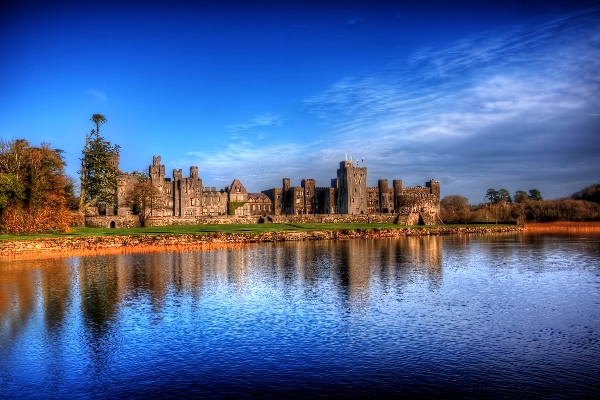
Elizabeth Toher Photography
Luxury at Ashford Castle
For an unparalleled, royal-worthy luxury experience, a stay at Ashford Castle in County Mayo along Ireland’s famous Wild Atlantic Way is a must. This 800-year-old castle, set on 350 acres along the shores of Lough Corrib, was established as a hotel in 1915 and is considered one of the most prestigious places to stay in all of Europe. Founded in 1228 by the Anglo-Norman de Burgo family after they invaded Ireland, it served as the centre of their aristocratic dynasty for more than three centuries. In 1852, it was purchased by Arthur Guinness of the famed brewery and remained in their family until it was sold in the early 20th century.
Meticulously restored, Ashford Castle boasts impressive interiors adorned with unique works of art, Donegal crystal chandeliers, panelled oak walls, hand-carved fireplaces, and exquisite fabrics throughout each of the 83 individually designed guest rooms. Besides exceptional dining featuring locally sourced produce and estate-grown ingredients, the historic property is home to Ireland’s first School of Falconry, a golf course, and a state-of-the-art spa. Guests can also try their hand at archery and clay shooting, enjoy a film in the 32-seat cinema, or sample some of the 60 Irish whiskies on offer at the Prince of Wales Bar.

Gavin McKay
Rock and Roll at Slane Castle
Home to one of Ireland’s most notable aristocrats, Henry Conyngham, Earl of Mount Charles, Slane Castle in County Meath is one of the most exciting historic buildings in the country. Set on a 1500-acre estate against the River Boyne in the Boyne Valley, it is a picturesque location only a few miles from the site of the Battle of the Boyne in 1690. Visitors can enjoy everything from a prepared picnic in the gardens, a fine meal at one of its two restaurants, or a tutored tasting of Irish whiskeys including Slane Irish Whiskey, produced at the castle’s distillery. A third of the building was destroyed by a fire in 1991, but it was restored over the course of a decade to its former glory.
Slane Castle is also renowned worldwide for its place in rock and roll history, hosting open-air concerts in its natural amphitheatre from rock royalty like Bob Dylan, The Rolling Stones, David Bowie, Queen, and Ireland’s own U2. Not only has U2 performed here three times, but it was also where they recorded their iconic album, The Unforgettable Fire, in 1984. The band lived in the castle and transformed its Drawing Room into a recording studio. The video for “Pride (In the Name of Love)” was filmed in the Gothic Revival Ballroom, originally created for a state visit from King George IV.

Chris Hill
Banqueting at Bunratty Castle
Bunratty Castle, located near Shannon Airport in County Clare, is acclaimed as the most complete and authentic castle in Ireland, plus its home to a herd of over 3000 deer. The last of four castles to be built here, the current structure is home to the world-famous Bunratty Castle Medieval Banquet, a dining and entertainment experience that has hosted over 3 million people since it was established in 1963. Guests feast on a four-course meal and honey mead while delighting in a lively musical performance.
The site of Bunratty Castle has a fascinating history. It was a Viking trading camp in the year 970 and was built as a defensive fortress in 1250 by Robert De Muscegros, a Norman. The first stone castle was built there by Thomas De Clare but was destroyed in a battle between the Irish and the Normans in 1316. It would be rebuilt and destroyed again two more times before the MacNamara family built the present castle in 1425, later becoming the stronghold of the O’Briens, North Munster’s largest clan.

Paul Mulcahy
A Canadian Connection at Malahide Castle
Malahide Castle is nestled on 250 acres of parkland in the seaside town of Malahide and was both a fortress and the private home of the Talbot family from 1185 until 1973 when the last Lord Talbot passed away. The estate became a tourist attraction in the 1980s and welcomes visitors to tour its grounds, including the oldest part of the castle, the central Norman tower house, and the walled botanic gardens. Step back in time as you wander through the grand Oak Room with its 17th-century furnishings and dark wood panelling, or the Great Hall, built in 1495 and the site of many notable banquets.
There’s a Canadian connection to Malahide Castle, too. It was the birthplace of Colonel Thomas Talbot, the personal secretary to John Graves Simcoe, Lieutenant-Governor of Upper Canada. Talbot established and supervised a settlement of 29 townships along the north shore of Lake Erie in the early 1800s, and even built a large log house which he named Malahide for his home in Ireland. Talbot died in 1853 and is buried in Elgin County, Ontario. Adding to the Canada connection is the “Old Jail” in London, Ontario, which was designed to resemble Malahide Castle.
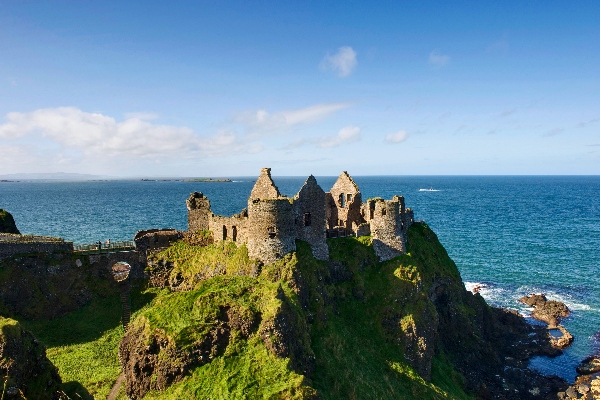
Chris Hill
Ancient Ruins at Dunluce Castle
Built by the MacQuillian family on the coastal cliffs of north County Antrim around 1500, Dunluce is home to some of the most hauntingly beautiful castle ruins in Ireland. The site of upheaval, violence, and rebellion, it was seized by the MacDonnell clan in the 1550s and under the leadership of infamous warrior chieftain Sorely Boy MacDonnell, they left their mark on the castle. It became the seat of the Earls of Antrim in the 17th century and a small town was established. It is located at the edge of a basalt outcropping and accessible via a bridge that connects it to the mainland.
With evidence of settlement since the first millennium AD, visitors can venture through archaeological digs of the long-abandoned Dunluce Town and hear tales of the stormy night in 1639 when the castle kitchens fell into the sea. That kitchen is still intact next to the manor house, and you can see the oven, fireplace, and entryways.
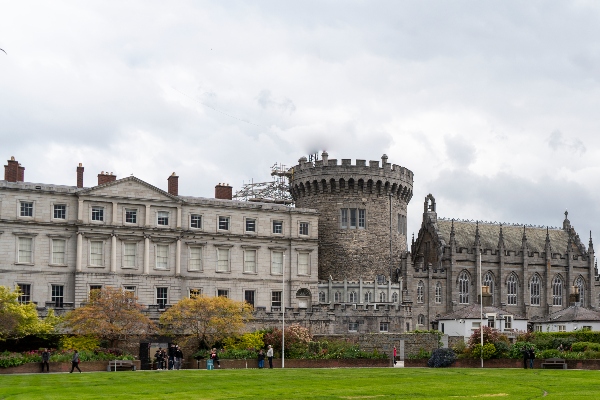
Sonder Visuals
Vikings at Dublin Castle
At the heart of historic Dublin is Dublin Castle, one of the most important buildings in Ireland’s history. The city itself gets its name from the Black Pool, or Dubh Linn, which was on the site of the present castle garden. The site’s history goes back to the Viking Age, and the castle was built in the thirteenth century where it was the seat of English and then British rule in Ireland from 1204 until 1922. It has served as a military fortress, a prison, a treasury, and courts of law. Now, it’s a government complex and an arena for state ceremony.
In addition to a storied collection of art including paintings, sculpture, glassware and tapestries, visitors flock to this site to see the subterranean chamber beneath the castle, where archaeological excavations have uncovered some of the original Viking defences, like a stone-covered embankment. The Viking remnants were discovered alongside some of the medieval castle’s structure. Both the Tower and Medieval Undercroft remain from the original 13th-century castle.
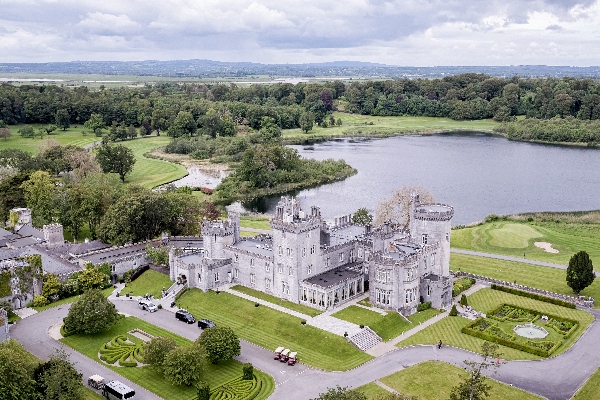
Dromoland Castle Hotel
Romance and Weddings at Dromoland Castle
Dromoland Castle has been welcoming guests to its 5000-acre estate in County Clare since the 16th century. The ancestral home of the O’Briens of Dromoland, the noble family’s lineage traces back 1000 years to Brian Boru, one of the last High Kings of Ireland. Donough O’Brien, one of Brian Boru’s sons, controlled Dromoland when it was a defensive stronghold and for the next 900 years, a branch of the O’Briens lived and ruled from the castle. It was sold in 1962 and reopened as a resort hotel after undergoing significant renovations.
Regarded as one of Europe’s finest resorts, modern comforts alongside historic grandeur and elegance make Dromoland Castle a popular spot for fairytale weddings where every guest is treated like royalty. With its striking baronial facade, regal decor, sumptuous dining, intimate spa and world-class golf course, the castle promises a memorable experience.

Gardiner Mitchell
Championship Golf at Lough Erne Resort
Lough Erne Resort may not be a medieval castle, but it was the site of recent history when it hosted the 39th G8 Summit in 2013 which was attended by former Canadian Prime Minister, Stephen Harper and former US President, Barack Obama. Tucked into 600 acres on a pristine Enniskillen peninsula in Northern Ireland, it offers a luxurious escape while embracing its natural surroundings and local traditions. Lough Erne is a modern property inspired by some of Ireland’s great castles, and is just a 9-minute drive away from the 600-year old Enniskellen Castle in the centre of town if you’re craving a bit more history.
With five-star accommodations, three distinct dining experiences and a Thai-inspired spa, Lough Erne Resort has everything you could want from an exclusive getaway. But it’s the two championship golf courses, Faldo, and Castle Hume, that attract guests from around the world to its secluded location.
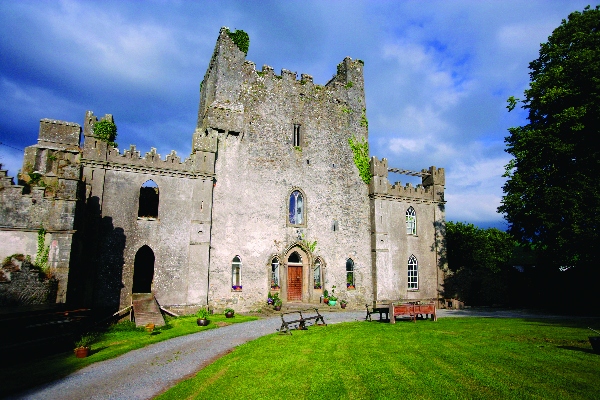
Brian Morrison
Haunted History at Leap Castle
One of the longest continually inhabited castles in Ireland – as well as the most haunted – County Offaly’s Leap Castle was built in the early 1500s by the O’Bannons, secondary chieftains under the ruling O’Carroll clan. Said to be built on a site that was used by Druids for initiation ceremonies, within the castle’s walls lurks Ireland’s most intriguing elemental presence, famed for its putrid, ghastly odour. An impressively fortified castle, the O’Carrolls used Leap to guard the pass through the Slieve Bloom Mountains. They were a fierce people set on domination and known for their bloody, ruthless ways. Leap was taken from the O’Bannons in 1642 by John Darby, an English soldier as part of Oliver Cromwell’s conquest of Ireland.
The castle has seen more than its fair share of bloodshed and violence over the centuries, and even its name is steeped in this brutal history. Originally called Leap of the O’Bannons, the legend says that two O’Bannon brothers who were contesting the chieftainship of their clan settled the bet with a display of bravery: jumping off the rocky outcrop where the castle was to be built. The Darbys inhabited the castle from 1642 until it was burned in 1922 during an uprising. Leap Castle was dormant until the 1970s when it was purchased by an Australian, Peter Bartlett, who began its restoration. The castle is now owned by the Ryans who are continuing the restoration and sharing its haunted history with visitors from around the world.
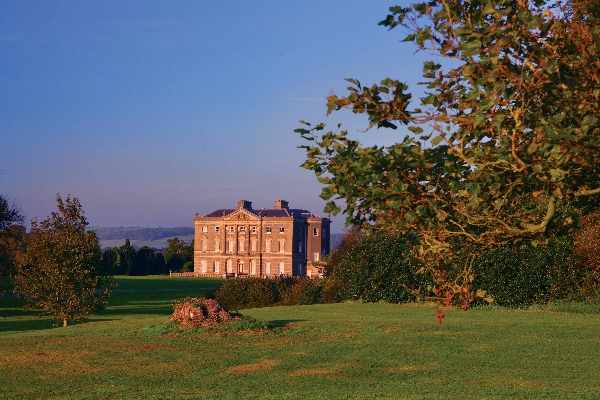
Brian Morrison
A Game of Thrones at Castle Ward
For the ultimate TV fan, a trip to Ireland wouldn’t be complete without visiting Castle Ward in County Down, one of the filming locations for Game of Thrones. You might recognize the castle’s Georgian farmyard as Winterfell, the ancestral home of the Stark family, and the archery range where the Stark children honed their skills. Along the shore of Strangford Lough, you’ll find the Whispering Wood, the site of a key battle between the Starks and Lannisters, as well as Robb Stark’s army camp, and the spot where Brienne of Tarth first confronts the Stark men. As you stroll around the estate, you’ll also recognize the setting for The Twins, home of Lord Walder Frey. Consider making a weekend of it by adding on a visit to Banbridge, about an hour from Castle Ward, for a visit to the official Game of Thrones Studio Tour.
Castle Ward itself is a fascinating place. It’s an 18th-century, double-sided mansion that’s a combination of Gothic and classical styles. Learn about the creators of the castle, particularly Lady Anne Ward, an independent-spirited woman who led a rather unconventional life. Besides the Game of Thrones connection, visitors can explore the collection of art within the castle itself, or venture through over 32 kilometres of trails by foot, bike or horseback.
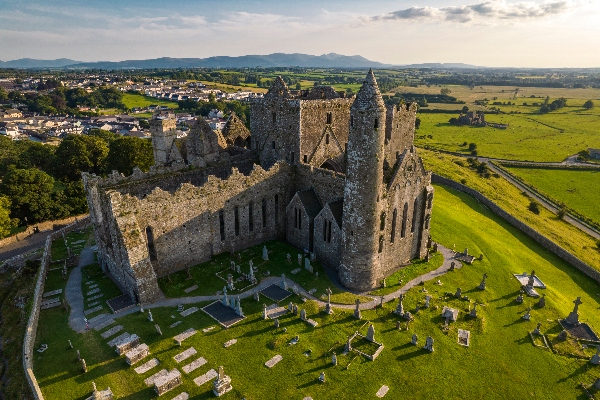
Jakub Walutek Photography
Myth and Legend at the Rock of Cashel
While not technically a castle, the Rock of Cashel, also known as St. Patrick’s Rock, is an ancient archaeological marvel and one of Ireland’s most visited attractions. Set on an outcrop of limestone in Tipperary’s Golden Vale, it has a cluster of medieval buildings including the 12th-century round tower, the oldest surviving structure on the site, and Cormac’s Chapel, one of the earliest churches built in the Romanesque style and home to the only surviving Romanesque frescoes in Ireland. There is also a high cross, a 13th-century Gothic cathedral, an abbey, the Hall of the Vicars Choral and the 15th-century Tower House.
The ancient royal site of the Kings of Munster, the Rock of Cashel was a fortress and centre of power going back to the 4th and 5th centuries. Legend says that when St. Patrick arrived in Cashel in the year 432, he baptized King Aengus who became Ireland’s first Christian king. In 990, it is where Brian Boru was crowned High King, the only ruler who was able to unite all of Ireland for a significant period. In 1101, the site was given to the church and became one of the country’s most important centres of ecclesiastical power.
Pack your bags and get ready to step back in time by embarking on an adventure through Ireland’s rich and storied history. Fill your heart with Ireland and visit Ireland.com to start planning your ultimate Irish getaway today.

